 Nuisance Fly Management - July 8, 2020 Jeff Schalau, Agent, Agriculture & Natural Resources University of Arizona Cooperative Extension, Yavapai County Flies come in many shapes and sizes. This diversity encompasses many species and each has slightly different habitat preferences and breeding cycle. Flies are always a nuisance during summer and fall, especially if you have horses, livestock, or poultry. Several species of flies commonly enter Arizona homes. Most are merely nuisance pests. Others are important because they can transmit diseases. House flies, face flies and blow flies develop in manure, carrion, and garbage and are commonly contaminated with disease-causing bacteria, including those associated with food poisoning. Stable and deer flies feed directly on domestic animals for blood meals, but in the absence of these hosts, they will feed on people. Stable flies develop in soggy hay, grasses or feed, piles of moist green material. Blow flies are scavengers, particularly of animal-based materials and commonly breed in carrion or pet waste. Fungus gnats can be found indoors breeding in potting media used for houseplants, hopping across the soil surface, or hovering near windows. Fly life cycles are similar, but vary in their breeding times and food preferences. In general, after breeding, female flies lay eggs which hatch into larvae (maggots) that feed on the various food sources listed above. Once mature, the larvae migrate in search of a place to pupate (the resting stage where the larva is transformed into an adult insect). Adults emerge to breed and feed. The entire life cycle is often completed in 7 to 14 days, but this depends on fly species and environmental conditions. Sanitation practices that remove breeding areas are fundamental to the control of filth-breeding flies, such as house flies and blow flies. Remove or cover garbage and clean spilled animal feed and manure. However, face flies, which typically develop in pasture lands, and cluster flies (earthworm parasites) often are difficult to control by breeding area management. Stable flies are a constant challenge for horse owners. However, proper care and management of waste feed and manure can greatly reduce or eliminate fly populations in these areas. Stalls should be cleaned of droppings daily and the manure spread thinly (not more than 1-2 inches deep). The choice of bedding is also very important. Hay or straw absorbs urine and decomposes rapidly and unless it is changed every few days will produce flies by the thousands. A far better material is wood shavings, which, when cleaned of manure daily and changed approximately every two weeks, does not normally breed flies. Screening and other exclusion techniques can be an important management tool for several types of indoor fly problems. Caulk or cover all openings into a home to prevent flies from entering. Several types of traps for flies also are available and can supplement other controls. Fly paper and electrocution light traps can kill flies but are effective only in areas where exclusion and sanitation efforts have already reduced the fly populations to low numbers. Various food-based traps also are for sale. These traps often contain a protein and/or sugar-based bait, sometimes with the addition of a pheromone (sex attractant) used by flies. As with other traps, they can supplement other controls such as sanitation and exclusion. These traps are effective for species that breed on carrion and garbage such as house flies and blow flies and should be placed near the highest concentration of flies. Pesticides are also available for fly control, but should be used in conjunction with prevention, exclusion, trapping, and cultural strategies listed above. Fly parasites can also provide biological control in problem areas such as stables and livestock feeding areas. Common fly parasites are small wasps that lay eggs on the pupae. These eggs hatch and the wasp larvae feed on the developing fly pupae. These insects can be ordered from vendors that sell beneficial insects. The wasps do not breed as fast as flies and similar other biological control strategies, will not provide 100% fly control. They must be used with prevention, exclusion, and trapping strategies listed above to have the greatest effect on fly populations. If you are thinking of trying biological control, release them in late spring so that they have the ability to become established. If pesticides are used in conjunction with biological control, make sure you are not negatively impacting the wasp parasites. See below for additional resources. You can follow the Backyard Gardener on Twitter – use the link on the BYG website. If you have other gardening questions, email the Master Gardener Help Desk in Prescott (prescottmg@gmail.com) or Camp Verde (verdevalleymg@gmail.com) and be sure to include your name, location, and phone number. Find past Backyard Gardener columns or provide feedback at the Backyard Gardener web site: https://cals.arizona.edu/yavapai/anr/hort/byg/. Images  In the background is a disposable fly trap surrounded by photos of common nuisance fly adults. Upper left: black blow fly (Colorado State University Extension); upper right: blue bottle fly (Colorado State University Extension); lower right: stable fly (Pavel Krok, Wikimedia Commons), and lower left: house flies a melon (Colorado State University Extension). The background photo is by Jeff Schalau, University of Arizona.
In the background is a disposable fly trap surrounded by photos of common nuisance fly adults. Upper left: black blow fly (Colorado State University Extension); upper right: blue bottle fly (Colorado State University Extension); lower right: stable fly (Pavel Krok, Wikimedia Commons), and lower left: house flies a melon (Colorado State University Extension). The background photo is by Jeff Schalau, University of Arizona.Additional Resources Flies in the Home, Colorado State University Extension extension.colostate.edu/topic-areas/insects/flies-in-the-home-5-502/ Fly Control Around the Home, Purdue University Extension extension.entm.purdue.edu/publications/E-7.pdf Controlling Houseflies, Texas A & M Agrilife Extension texashelp.tamu.edu/browse/by-type/agriculture-disasters/insects/houseflies/ Household Flies, University of Missouri Extension extension2.missouri.edu/g7388 |